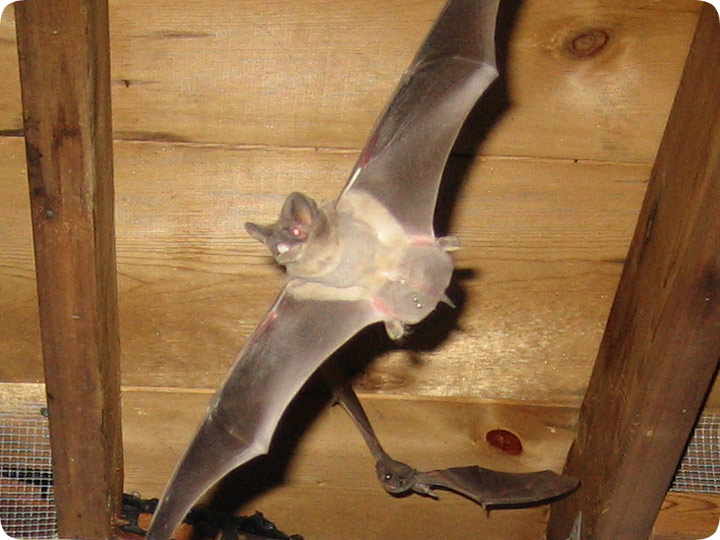-
info@aaanimalcontrol.com
Call us for help in your town
Humane Wildlife Education
Does Bat Trapping Work?

It's true that many, if not most, nuisance wildlife species are controlled via trapping. If you've got a raccoon in your attic, you've likely got to set traps to catch it and remove it from the property. However, bats shouldn't be trapped. Some uninformed companies practice bat trapping, and bat traps are in fact sold, but they're stupid (both the traps and the companies).
Here's how it works if you have bats in your building. First of all, you've got to find out how they're getting in. It could be one tiny hole, it could be 2000 linear feet of open fascia board, it could be rotting wood, open vents, etc. Whatever the entry, it's got to be found, all of the spots must be found, and sealed. However, the main spots that the bats use to enter and exit must be left open, and the bats allowed to exit these areas through one-way exclusion doors/nets/tunnels, etc.
Most bat traps follow the same principle: a one-way tunnel, but instead of allowing the bats to fly free, the trap holds them, like in a box. The trap usually inhibits full exit of all the bats, and then once inside, they are at risk - often they are exposed to heat or the cramped conditions kill these fragile animals. It is illegal to kill a colony of bats, and BCI (Bat Conservation International) condemns the use of bat traps. I mean, once the bats are trapped, then what? You can't kill them, so you must let them go. You'd have to relocate them thousands of miles to ensure that they wouldn't just migrate right back to their original territory in a matter of days. So why bother to expose the bats to health risks, expose yourself to lawbreaking, and make the job potentially less effective, when you can do it right, the BCI recommended way, the reasonable professional way, of just excluding them? The home must be sealed 100%, or new bats will get back in, so it's essential that the bat removal specialist seal up the building properly.
Please, do not resort to bat trapping, or hire anyone who engages in it. Find a wildlife trapper who will, when it comes to bats, be a wildlife excluder. It's the right way to handle the job, the legal way, and the best for these marvelous creatures.
Do it yourself: Visit my How To Get Rid of Bats page for tips and advice.
Get professional help: Visit my Nationwide Pro Directory of wildlife removal experts.
For more wildlife stories, click my Wildlife Blog or click my below banner to hire a local trapper.

If you have noticed bats going in and out of a crevice in the frame of your house or have seen them going into your attic near the chimney, you may have a bat problem. Bats like to live in areas like the attic because it is dark and normally quiet. The problem with having a family of bats occupying your attic is that they defecate in the area where they hang out the most. They also have their babies in this location as well. Together, the combination is unsanitary in every way.
Bat feces carries with it a lot of diseases that can be passed on to humans as well as pets inside the home. When this happens, you can become very sick or just mildly ill and mistake it for a cold or something else minor. Bat feces can contain dangerous spores that when inhaled can make you sick. This is why it is very important that you get rid of them as soon as you notice there is a problem.
Types of Bat Traps
One-way netting or tunnels can be a way to get the bats out of your home for good. This device will consist of a piece of nylon netting that will attach around the area you see the bats going in and out of. When you place the netting and secure it with duct tape or something that holds well, you will only secure three of the four sides. The bottom side will hang down approximately two feet below where they are going in and out of. The bats will then crawl down the netting to fly away and when they come back to go inside, they don’t know how to get back in through the netting.
A cage trap is another option for trapping bats. With a cage trap, you will tunnel chicken wire over the area that the bats are using to go in and out of. This will guide the animal inside the cage trap the moment they exit their nest. The problem with these traps is that the bat cannot locate the exit to get out so they try to fly away with no results. They end up exhausting themselves and if you don’t check the traps often, they will die trying to escape.
Glue traps are also an option. With these traps, you create them using cardboard that is covered in a sticky glue. Once the bat touches the sticky glue, they will not be able to move to get food or water and will die. This is the most painful death for a bat because they suffer before they die.
Relocating a bat is another option. To do that, you will need to hire a professional that can go in your attic and capture the bat safely and the babies if they are present and place them in a portable cage to move them to a location where they can find a new home.




















